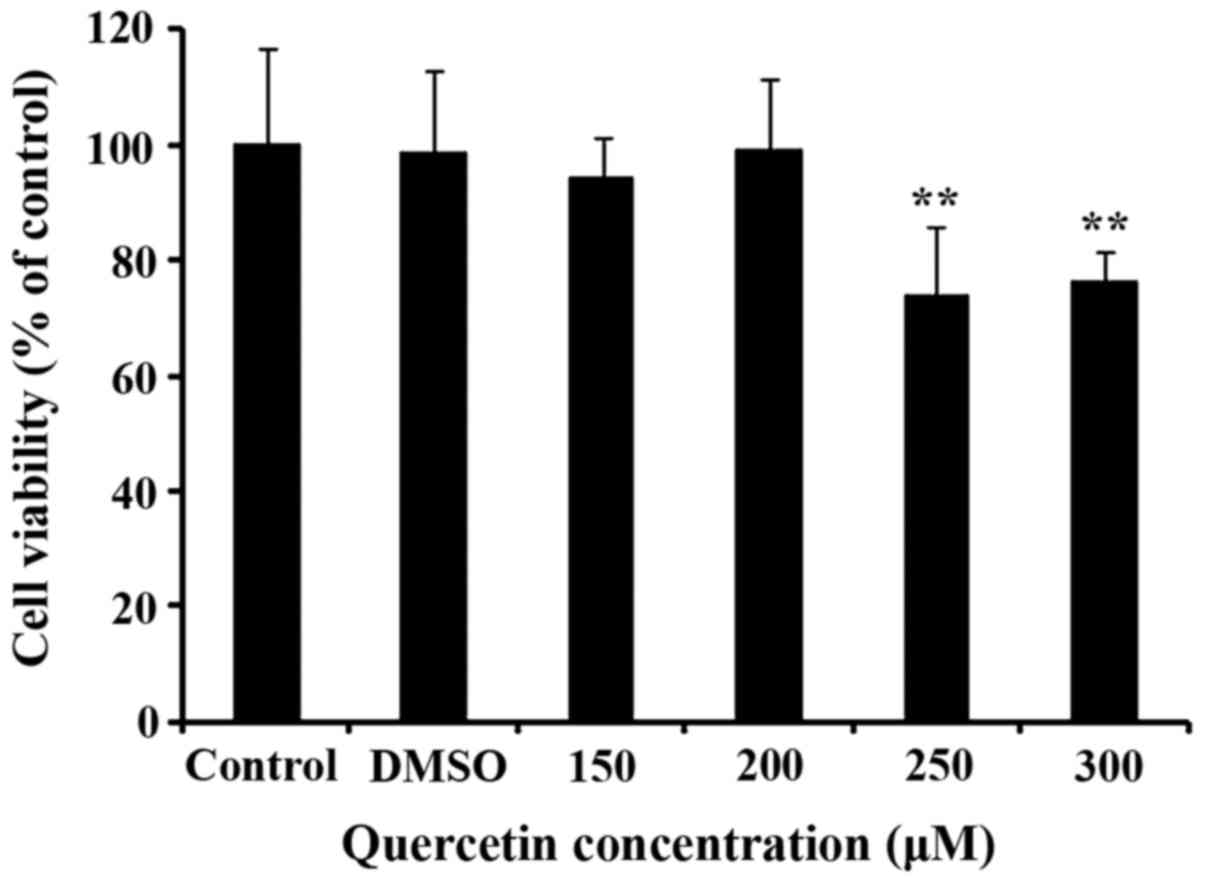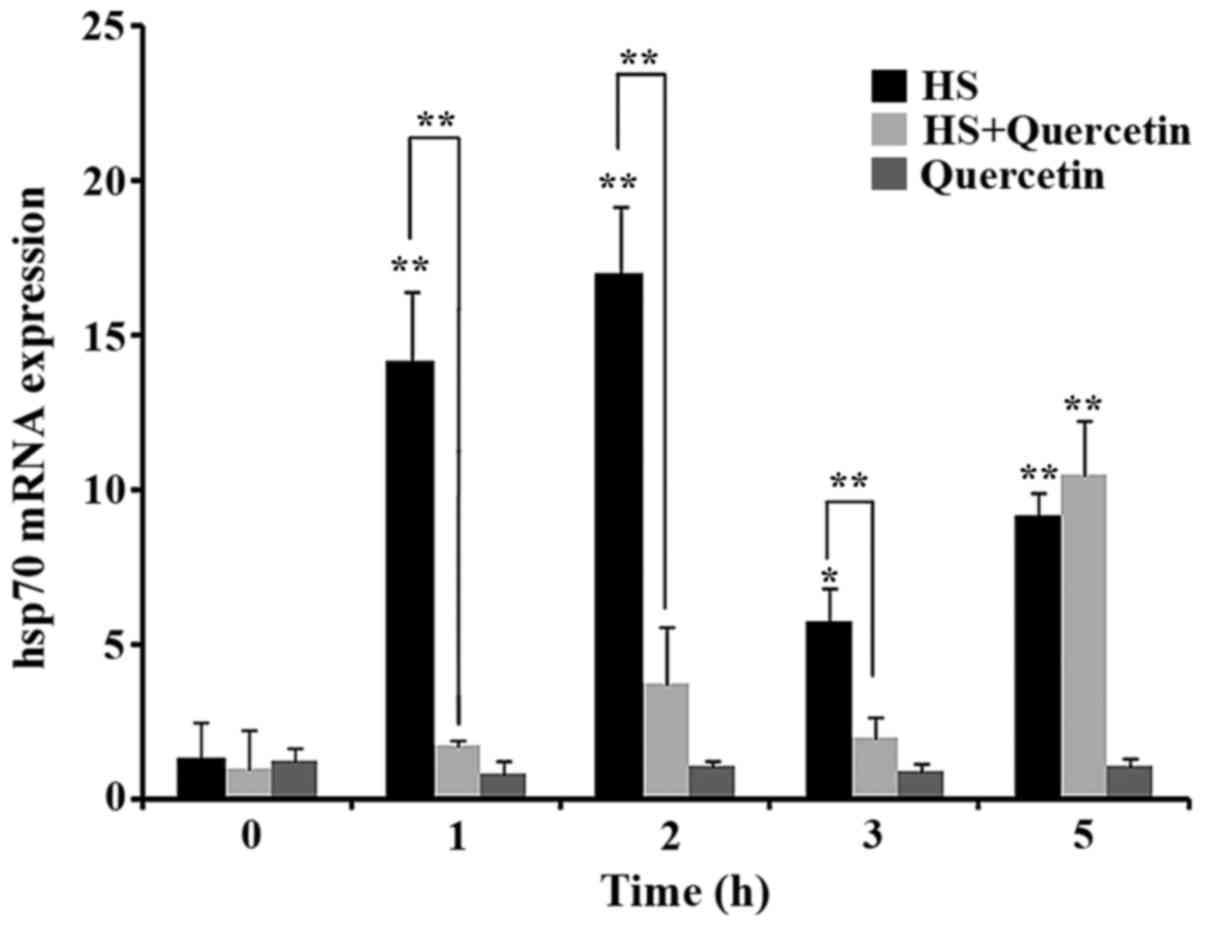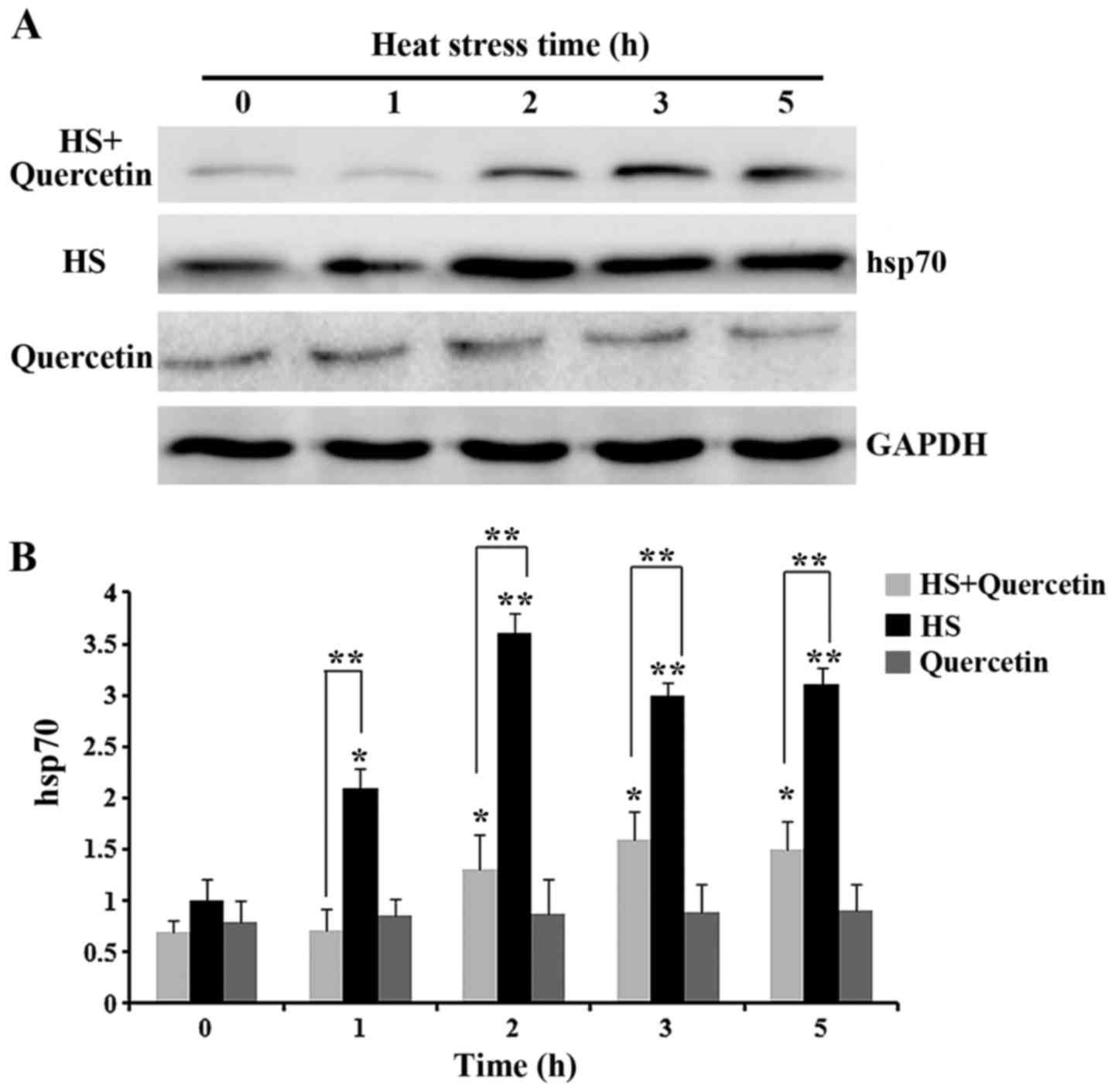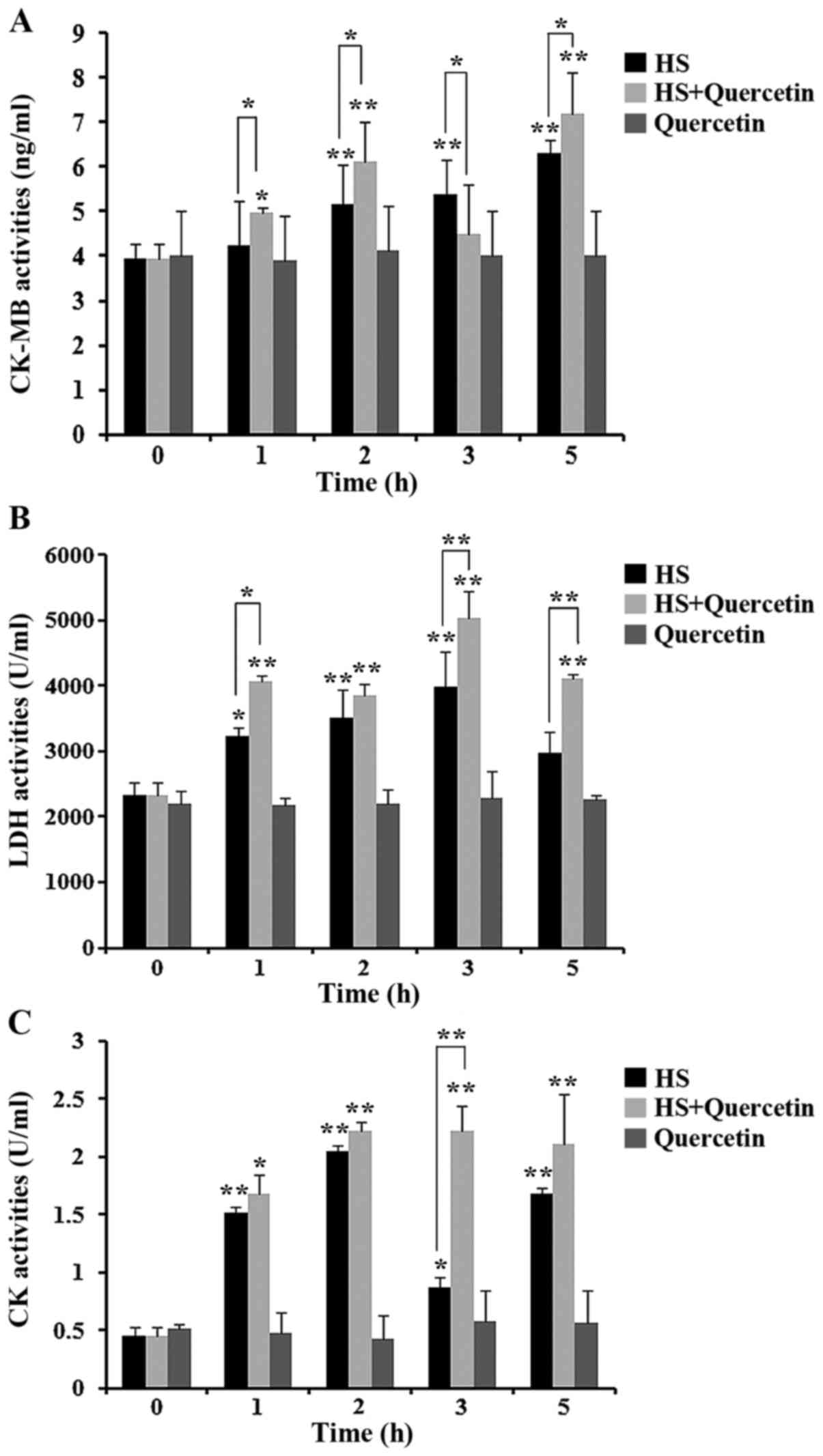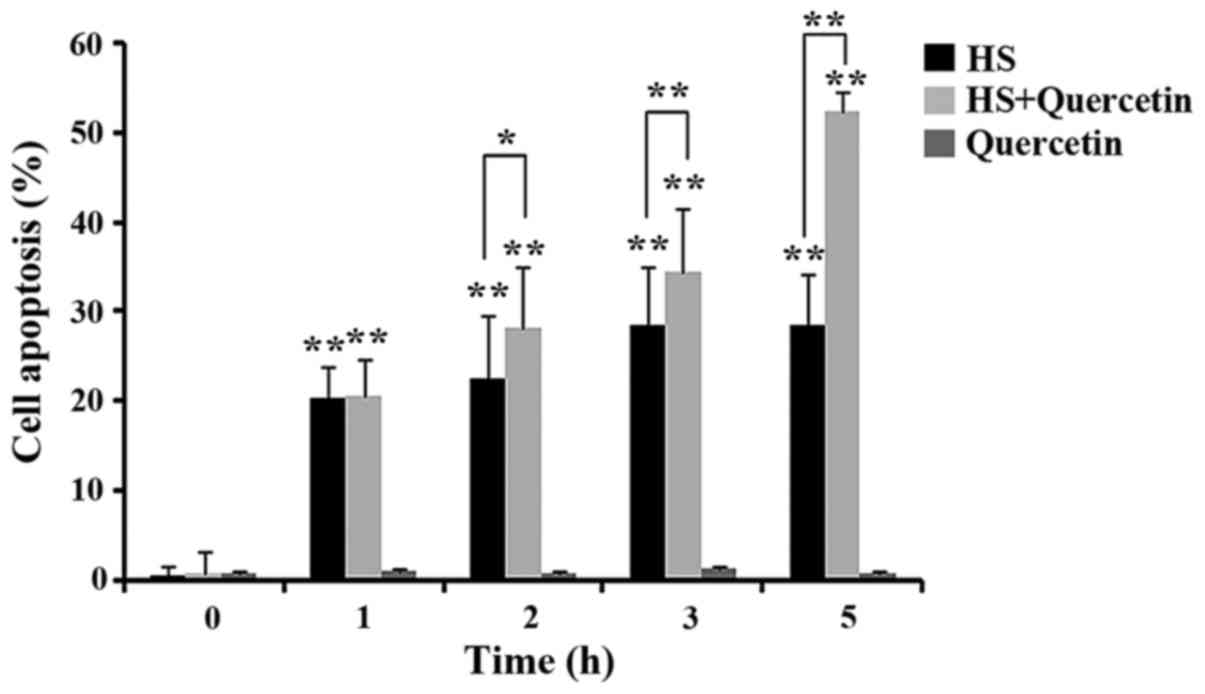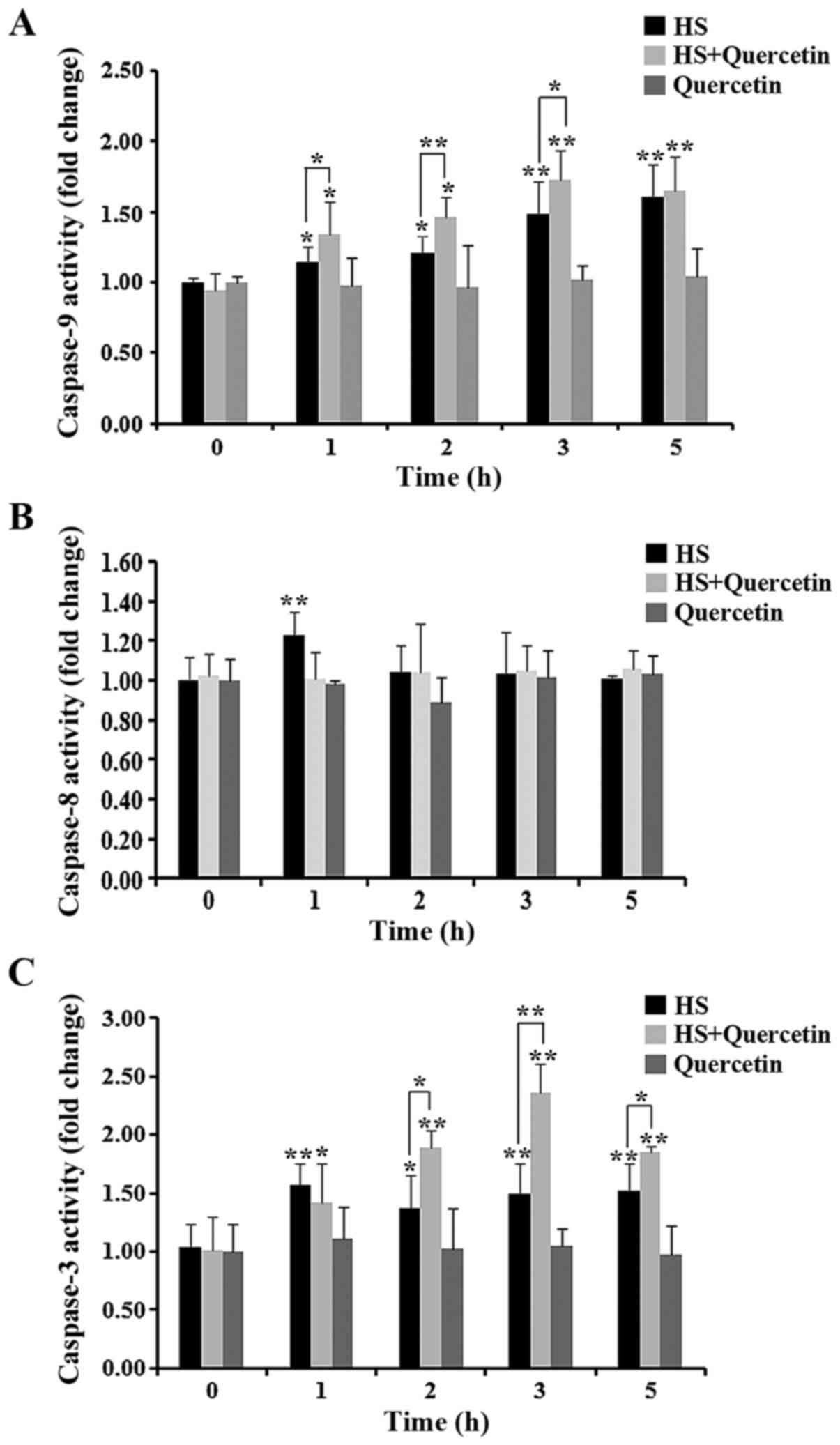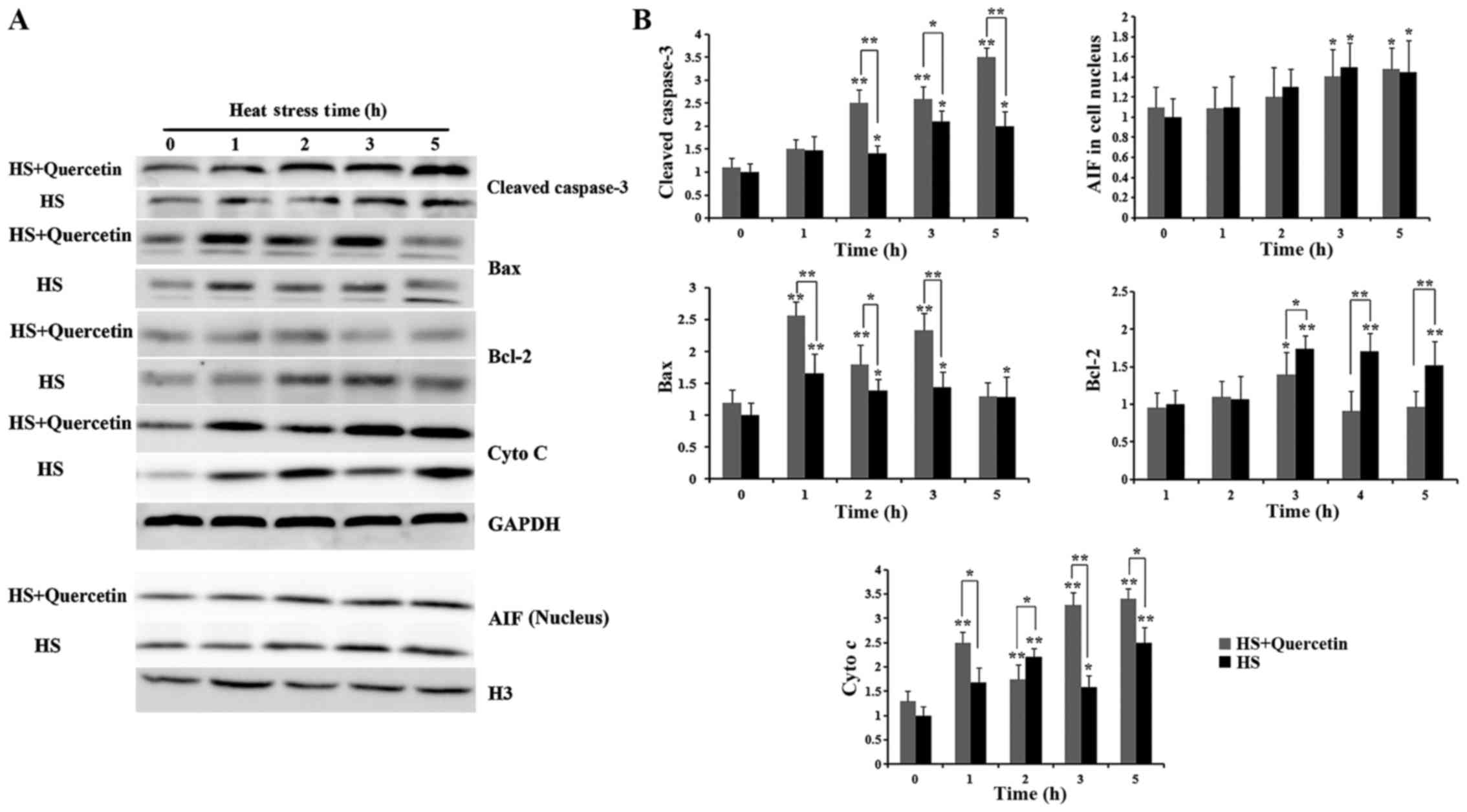Inhibition of heat shock protein 70 intensifies heat-stressed damage and apoptosis of chicken primary myocardial cells in vitro
- Authors:
- Published online on: March 16, 2017 https://doi.org/10.3892/mmr.2017.6337
- Pages: 2881-2889
Abstract
Introduction
In animals, Selye defined stress to be a non-specific general reaction upon different types of stimulation (e.g., cold, surgical injury, hyperthermia) (1). Stress can lead to disease (or even death) if it is sustained and of high intensity (2).
Heat stress (HS) has been researched widely because of its negative effects. Research has shown that losses of US$2.4 billion occurred in the US poultry industry because of a lack of heat-abatement equipment (3). High temperature has been shown to elicit negative effects on broiler chickens, including increased consumption of fodder as well as a reduced growth rate and viability of chickens (4). It can also increase the abdominal fat of broiler chickens, thereby reducing the quality of products derived from them (5). Gathiram et al discovered that HS can cause endotoxemia and lead to the death of monkeys, suggesting that the damage causes by HS in mammals may also have serious consequences (6). Oxidative damage to proteins and lipid peroxidation induced by HS has also been reported (7).
Cardiac failure and stroke can be induced by varies types of stress, including hyperthermia (6,8). Sudden cardiac death can occur in broiler chickens because of hyperthermia (9). Pathologic examination of chicken hearts has shown vacuoles and karyopyknosis after HS (10). Hyperthermia can induce tissue damage (especially heart failure) in rats (11). Studies in dogs have shown that HS can induce collapse of cardiovascular function and death (12). Therefore, the heart might be damaged more easily than other organs in humans or livestock.
The heat shock protein (Hsp) family is a group of proteins that are highly conserved. Hsps can be found in virtually all organisms. They act as ‘cellular chaperones’ in animals under normal physiologic or pathologic conditions. Stresses such as hyperthermia, oxidative damage, or physical/chemical injury can upregulate Hsp expression dramatically and rapidly (13). According to their molecular weight, the Hsp family can be divided into small Hsps, Hsp40, Hsp60, Hsp70, Hsp90, and Hsp110 (14). They can combine with misfolded/unfolded proteins to help them fold in the correct way. Also, denatured proteins can be removed by Hsps to maintain the normal physiologic function of cells (15,16). Hsp40 could sense oxidative stress to act as the first line of defence against oxidative which was similar with Hsp27 (17,18). Hsp60 was found to inhibit bax in mitochondrial and reduce the cell apoptosis (19). Zhang's research indicated Hsp90 induced by aspirin could alleviate the chicken primary myocardial cells damage and apoptosis during HS (20).
Hsp70 is one of the most important members of the HSP family, As well as being a molecular chaperone, it can facilitate DNA repair in human bronchial epithelial cells if exposed to toxins such as benzo-a-pyrene (21). Studies have shown that Hsp70 expression in healthy myocardial cells is quite low, but is increased significantly after HS (22), suggesting that Hsp70 might be induced readily by HS and has physiologic roles in cardiac cells during HS. Hsp70 is effective for the survival of cells and tissues by combining with hydrophobic regions in unfolded proteins in an adenosine triphosphate (ATP)-dependent manner to stabilize the unfolded state and then help proteins recover into a folded state. Li et al discovered that Hsp70 overexpression by heat-shock pretreatment can reduce the liver injury induced by carbon tetrachloride and accelerate liver repair in rats, and that these phenomena may be related to the anti-oxidative properties of Hsp70 (23). Research has also shown that inhibition of Hsp70 expression by micro-injection of monoclonal antibodies against Hsp70 can weaken the survival and tolerance of fibroblasts during HS in vitro (24). Hutter et al demonstrated that the infarct size caused by acute occlusion of the left main coronary artery followed by reperfusion is decreased because of Hsp72 overexpression in transgenic mice (25). Other studies have suggested that Hsp70 has anti-apoptotic effects in several cell types. Wang et al discovered that induction of Hsp70 expression by geranylgeranylacetone suppresses HS-induced apoptosis of mouse cardiomyocytes in vivo (26). Increased expression of Hsp70 by mild HS can also increase resistance to subsequent severe HS in neuronal cells (27). Those results suggest that Hsp70 overexpression can alleviate apoptosis during HS. Yurinskaya et al showed that Hsp70 can decrease the percentage apoptosis induced by isoAsp7-Aβ (1–42) (isoAsp7-Aβ (1–42) is the amyloid-β isoform with isomerized aspartic acid residue at position 7) in human neuroblastoma cells, and that this phenomenon is related to the protein kinases JNK, ERK and PI3K (28). The cell-free system established by Beere et al showed that Hsp70 can hinder the recruitment of pro-caspase-9 to the apoptotic peptidase activating factor-1 (Apaf-1) apoptosome to execute its anti-apoptotic effects (29). Hsp70 can combine with the death-associated protein kinase Apaf-1 to inhibit downstream activation of Apaf-1 and caspase-9 to achieve its anti-apoptotic function during stress (30,31). Therefore, Hsp70 could be an indispensable protein in myocardial cells in vivo and in vitro during HS.
Previously, we have shown that heart damage in chickens is quite obvious after HS. Research teams of Wu noted that levels of enzymes related to heart damage (e.g., creatine kinase) (CK), CK-MB, lactate dehydrogenase (LDH) are elevated significantly after HS in broiler chickens, suggesting that HS can induce damage to myocardial cells (10). Hsp70 may have a protective role in rat myocardial cells in vivo and in vitro because groups with low expression of Hsp70 have shown more severe damage than groups with high expression of Hsp70 (32). The remarkable role of Hsp70 has also been investigated in other types of stress, such as transport stress. Hsp70 expression in the pig stomach has been shown to be associated with protective functions (33). The cytoprotective role of Hsp70 has been researched widely, but little is known about its effects in the primary myocardial cells of chickens in vitro.
In the present study, we established a cellular model of low expression of Hsp70 and also investigated Hsp70 expression in the primary myocardial cells of chickens using quercetin. [Quercetin is a flavonoid known to inhibit Hsp70 expression and has been used against several types of cancer, such as adenocarcinoma and leukemia, to target Hsp70 (34–36)]. The protective role of Hsp70 was measured by detection of apoptosis and its related cascades, pathologic damage, and other parameters in normal chicken primary myocardial cells (CPMC) and a cellular model of low expression of Hsp70 during HS in vitro.
Materials and methods
Culture of CPMC
All experiments were undertaken in accordance with the guidelines of the Animal Ethics Committee of Jiangsu Province (China). The study protocol was approved by the Animal Care and Use Committee of Nanjing Agricultural University (Nanjing, China). Specific pathogen-free embryonated embroys (12 days of age; Qian Yuan Hao Biotechnology Company, Nanjing, China) were harvested. Hearts were removed under sterile conditions and cut into pieces before washing four times in phosphate-buffered saline (PBS). Collagenase type I (1 mg/ml; Life Technologies, Carlsbad, CA, USA) was added to digest heart fibers at 4°C for 14–16 h. The reaction was terminated by addition of Dulbecco's modified Eagle's medium (DMEM; Life Technologies) with 20% fetal bovine serum (FBS; Life Technologies) before centrifugation at 1,000 × g for 10 min at 4°C. Primmorphs were resuspended by DMEM containing 20% FBS, 100 units/ml penicillin and 100 units/ml streptomycin before culture in cell culture plates in a humidified atmosphere of 5% CO2 and 95% air at 37°C. Cells were transferred to new cell culture plates after 1 h and 0.1 mM 5-Bromo-2-deoxyuridine solution (Sigma-Aldrich, St. Louis, MO, USA) was added to the culture solution to inhibit the growth of fibroblast. Cells were cultivated for 48 h.
Cell viability assay
The 3-(4,5-dimethylthiazol-2-yl)-2,5-diphenyltetrazolium bromide salt (MTT) assay was employed to determine cell viability when different concentrations of quercetin (dissolved in dimethylsulfoxide (DMSO; Sigma-Aldrich)) were added. Final concentration of DMSO in the culture medium was 0.1%. CPMC were incubated in 96-well plates at 1×104 per well for 48 h. Then, quercetin (150, 200, 250, 300 µM) was added for 24 h. As a control solution, 0.1% DMSO was added in triplicate. Then, 10 µl MTT (0.5 mg/l) was added to each well, and the plate transferred to a system at 37°C to allow formation of blue formazan crystals. The remaining MTT was removed after 2 h and 150 µl DMSO added for 30 min. After shaking for 1 h, absorbance was measured at 570 nm by a spectrophotometer (Infinite 200 PRO; Tecan, Geneva, Switzerland).
HS model in CPMC
Cells (3–4×106) were plated in cell culture dishes (diameter, 60 mm). Then, cell plates were divided randomly into the inhibitor group [HS+Quercetin; in which 200 µM quercetin (Sigma-Aldrich) dissolved in DMSO was added to the culture solution 1 h before HS. Final concentration of DMSO was 0.1%] and HS group (which was treated with the same amount of DMSO as inhibitor group and a humidified atmosphere of 5% CO2 and 95% air at 42°C), quercetin group which was treated with quercetin without HS. Duration of HS was 0, 1, 2, 3 and 5 h (n=3).
Semi-quantitative measurement of transcription of Hsp70 mRNA
Treated CPMC were collected by TRIzol Reagent (Life Technologies) for measurement of total RNA according to manufacturer instructions. Then, RNA samples were reverse-transcribed into cDNA by a Transcript M-MLV kit (Life Technologies) according to manufacturer instructions. All cDNA samples were stored at −20°C. Sequences of Hsp70 and glyceraldehyde-3-phosphate dehydrogenase (GAPDH) were supplied by the gene bank of the National Center for Biotechnology Information. Primers of target genes were designed by Primer Premier v5.0. Primers of Hsp70 (forward and reverse) were AGC GTA ACA CCA CCA TTC C and TGG CTC CCA CCC TAT CTC, and those for GAP DH were TGA AAG TCG GAG TCA ACG GAT and ACGCTCCTGGAAGATAGTGAT, respectively. Expected size of Hsp70 and GAPDH polymerase chain reaction (PCR) product was 372 and 230 bp, respectively. A thermocycler (AB7300; Life Technologies) was employed for quantitative PCR. Levels of Hsp70 mRNA were normalized using the following formula:
RelativequantityofHsp70mRNA=2–ΔΔCq–ΔΔCq={[(CqHsp70mRNA–CqGAPDHmRNA)Heatstressgroup]–[(CqHsp70mRNA–CqGAPDHmRNA)Controlgroup]}Expression of Hsp70 protein
Protein in CPMC of the HS group, HS+Quercetin group and Quercetin group was collected by RIPA Lysis Buffer containing 1% phenyl methane sulfonyl fluoride according to manufacturer instructions. The supernatant was collected by a pipette when the mixture was centrifuged at 12,000 × g for 15 min. Protein concentration was measured by a bicinchoninic acid (BCA) assay kit (Life Technologies) according to manufacturer instructions. Each sample was boiled for 15 min and then stored at −20°C. For sodium dodecyl sulfate-polyacrylamide gel electrophoresis, each track was loaded with an equal amount of protein (30 µg). Then, the protein was transferred onto a polyvinylidene fluoride (PVDF) membrane (Bio-Rad, Hercules, CA, USA) at 120 V for 90 min. Then, 5% skimmed milk powder dissolved in PBST was employed to block the PVDF membrane at 37°C for 2 h. After washing with PBST, the PVDF membrane was incubated with anti-chicken Hsp70 and GAPDH monoclonal antibody (Abcam, Cambridge, UK) for 16 h at 4°C. After the first incubation, the PVDF membrane was washed four times with PBST before incubation with the corresponding peroxidase-conjugated goat IgG antibody (Boster, Beijing, China). Luminous fluid was used to detect the protein on the membrane. Bands on the developed film were quantified using Quantity One v4.6.2 (Bio-Rad). Relative amount of Hsp70 was normalized using the following formula:
RelativeamountofHsp70=(GrayvalueofHsp70–Grayvalueofbackground)/GrayvalueofGAPDH–Grayvalueofbackground)Heart damage-related enzymes
Supernatant (3 ml) of CPMC were collected from each group after HS. Activities of pathologic damage-associated enzymes of myocardial cells (CK, CK-MB, LDH) were tested using kits (Nanjing Jiancheng Biochemical Reagent, Nanjing, China) according to their instructions.
Detection of CPMC apoptosis during HS
CPMC were washed twice with pre-cooled FACS Buffer after HS. Pancreatic enzymes without ethylenediamine tetra-acetic acid were used to digest CPMC. After resuspension with 200 µl binding buffer, 10 µl annexin V-fluorescein isothiocyanate and 15 µl propidium iodide were added. Flow cytometry was employed for all samples within 1 h. FlowJo v7.6.1 was used for data analyses.
Activities of caspase-3, −8 and −9 after HS
CPMC were collected after HS. Protein concentration in cells was measured by BCA kits. Cells were added to 96-well plates, and each well contained 100–200 µg protein. Activities of caspase-3, −8 and −9 (which are associated with apoptosis) were detected using kits (Nanjing KeyGen Biotech Co., Ltd., Nanjing, China) according to their instructions.
Expression of cleaved caspase-3, AIF, Bax, Bcl-2 and cytochrome c
Apoptosis-associated proteins in CPMC of the HS group and HS+Quercetin group was detected according to western blot by anti-chicken AIF, Cleaved caspase-3, Bax, Bcl-2 and cytochrome c monoclonal antibody (Santa Cruz Biotechnology, Inc., Santa Cruz, CA, USA).
Statistical analysis
Differences between experimental groups and the control group were analyzed by one-way analysis of variance followed by the least square difference multiple comparison test using SPSS (IBM, Armonk, NY, USA). Results are the mean ± standard deviation (SD). P<0.05 was considered significant and P<0.01 was considered highly significant. Unless indicated otherwise, experiments were done in triplicate.
Results
Cell viability after quercetin treatment
The effect of different concentrations of quercetin on CPMCs after 24 h is shown in Fig. 1. Cell viability was reduced significantly by ~25% at 250 and 300 µM quercetin, but the other groups were not influenced. According to these results, a quercetin concentration of 200 µM was selected for experimentation.
Transcription of Hsp70 mRNA during HS
The transcription level of the RNA of the housekeeping gene GAPDH did not change in response to HS. The transcription level of Hsp70 mRNA increased significantly (P<0.01) from the beginning of HS (1 h) in the HS group. In contrast to the HS group, the transcription level of Hsp70 mRNA in HS+Quercetin group did not change significantly (P>0.05) until 5 h (P<0.01). No obvious change was discovered in Quercetin group (P>0.05). These results suggested that quercetin inhibited Hsp70 mRNA transcription during HS within 5 h (Fig. 2).
Hsp70 expression of during HS
Expression of Hsp70 in HS group, HS+Quercetin and Quercetin group was normalized to that of the housekeeping gene GAPDH (Fig. 3). At 0 h, Hsp70 had low expression in CPMC, but then increased significantly (P<0.05) from 1 h of HS and maintained high expression until 5 h (P<0.01). After quercetin treatment, Hsp70 expression was reduced highly significantly compared with that in the HS group. Expression of Hsp70 in Quercetin group was quite low and no change was discovered (P>0.05). These results suggested that quercetin caused low expression of Hsp70 in CPMC within 5 h of HS, however, quercetin failed to decreased the expression of Hsp70 without HS.
Levels of heart damage-associated enzymes during HS
Levels of CK-MB, LDH and CK released from heat-stressed CPMC were detected in the supernatants of all groups (Fig. 4). After HS, levels of these three enzymes were significantly higher (P<0.05) in HS group and HS+Quercetin group. However when Hsp70 was inhibited in HS+Quercetin group, CK-MB release was significantly greater (P<0.05) than the HS group 1, 2 and 5 h after HS. Also LDH levels were significantly higher in HS+Quercetin group at 1 (P<0.05), 3 and 5 h (P<0.01) compared with the HS group. CK showed a similar trend to the other two enzymes. Between the two treatment groups, CK release was threefold higher at 3 h than in the HS group. No cell damage was discovered in Quercetin groups. Enzyme activities suggested that damage to CPMC in the Hsp70 low-expression group (HS+Quercetin) was more than that in the HS group.
Apoptosis of CPMC during HS
Apoptosis in all experimental groups was shown in Fig. 5. At 0 h, All of the groups showed no obvious apoptosis. After 1 h of HS, apoptosis was observed in HS- and quercetin-treated group, but there was no significant difference between them. Percentage of apoptotic cells in the inhibitor group was higher compared with the HS group at 2 (P<0.05), 3 and 5 h (P<0.01), and a considerable number of non-viable apoptotic cells was observed at 5 h. No apoptosis was discovered in quercetin groups without HS (P>0.05). These results suggested that apoptosis became more severe in the group which Hsp70 expression was inhibited.
Levels of apoptosis-associated enzymes during HS
Levels of the apoptosis-related enzymes caspase-9, −8, and −3 are shown in Fig. 6. Almost no change in caspase-8 activity was observed during HS in all experimental groups. Levels of caspase-9 and caspase-3 were elevated significantly at the start of HS. Quercetin-treated CPMC showed higher levels of caspase-9 at 1, 2 and 3 h compared with the HS group. Caspase-3 levels were also significantly (2 and 5 h) or highly significantly (3 h) elevated in HS+Quercetin groups during HS. When treated with quercetin alone, all of the enzymes showed no change during 5 h.
Levels of heart apoptosis-associated proteins during HS
Levels of cleaved caspase-3, AIF, Bax and cytochrome c are shown in Fig. 7. Expression of cleaved caspase-3 was significantly elevated at the start of HS in both groups, quercetin-treated CPMC was higher than that in HS groups during HS at 2 (P<0.01), 3 (P<0.05) and 5 h (P<0.01). As for AIF, though expression of AIF in cell nucleus was elevated at 3 and 5 h (P<0.05), no obvious difference was observed between two groups during HS. Expression of Bax in Quercetin-treated CPMC was significantly elevated compared with HS group at 1 (P<0.01), 2 (P<0.05) and 3 h (P<0.01). Expression of Bcl-2 in HS+Quercetin group didn't show obvious change during HS except 2 h and was lower in quercetin-treated groups at 2 (P<0.05), 3 and 5 h (P<0.01). Cytochrome c was upregulated by HS in both groups, however, levels in HS+Quercetin (Hsp70 low expression) groups were significantly higher at 1 (P<0.05), 3 (P<0.01) and 5 h (P<0.05) compared with HS group.
Discussion
If cells suffer HS, intracellular proteins undergo oxidation, and proteins that can ‘sense’ this change become misfolded (37). Hsp70 can be induced readily during severe stress and can act as a ‘sensor’ for such misfolded proteins.
Studies have shown that Hsp70 is expressed in several cell types under HS (38–40). However, the importance of Hsp70 in myocardial cells (especially those in poultry) under HS is not known. To ascertain if Hsp70 has a protective role in chicken myocardia, we inhibited Hsp70 expression using quercetin in CPMC. Inhibition of the transcription and translation of Hsps has been investigated (41,42). Also, to ascertain if quercetin can affect CPMC viability, we used the MTT assay. We found that CPMC were unchanged after using quercetin (200 µM) and our results also showed quercetin was no-harmful to CPMC without HS. Therefore, all further apoptosis and heat stressed-damage were not induced by quercetin itself, but by a shortage of Hsp70. Western blotting showed that Hsp70 expression was obviously elevated at the start of HS in both groups. However, Hsp70 expression in the quercetin-treated group was reduced significantly compared with that in the HS group. PCR data revealed that expression of Hsp70 mRNA was also reduced in the quercetin-treated group according. These results suggest that 200 µM quercetin can obviously inhibit transcription of mRNA and protein expression of Hsp70 during HS. These results also demonstrate that a model of low expression of Hsp70 was established.
CK, CK-MB and LDH are present in myocardial cells and possess different biologic activities. Studies have shown that these enzymes can be released from the cytoplasm if cells are damaged. Thus, concentrations of these enzymes in cellular supernatants can reflect the extent of cell damage (43). CK and CK-MB are associated with energy transfer, muscle contraction, and ATP regeneration in cells, and are regarded as specific diagnostic factors for myocardial damage (44). Previously, we showed that transport stress can cause pathologic damage to the myocardial cells of piglets, and that LDH levels are a damage criterion of myocardial cells (45). Here, we discovered that activities of CK-MB and LDH in the quercetin-treated group were elevated significantly, and that CK levels were also higher than those in the HS group. These results confirmed our hypothesis that damage to CPMC is associated with inhibition of Hsp70 expression.
Studies have demonstrated that HS can induce oxidative stress in livestock (46,47). Hsp70 can sense the redox status of organisms and upregulate the level of oxidation of non-protein thiols (especially glutathione) to execute an anti-oxidative effect (48,49). On the basis of those studies, we hypothesized that inhibition of Hsp70 expression may be associated with damage to CPMC during HS.
Apoptotic cells were not observed under the non-HS state in the HS group and HS+Quercetin group. When both groups were exposed to HS, 20% apoptosis appeared from 1 h onwards. Apoptosis increased with increasing duration of HS. In the Hsp70 low expression group, significantly more apoptotic cells were observed compared with the HS group at 2–3 h of HS, and >50% apoptosis was noted in the Hsp70 low expression group at 5 h compared with 28% apoptosis in the HS group. Results of western blot also indicated Cleaved caspase-3, the performer of cell apoptosis, was higher in inhibitor group during HS, We hypothesized that reduced expression of Hsp70 may be a key reason for the increase in apoptosis of CPMC during HS. Detection of apoptosis-related enzymes showed that caspase-8 activity was not elevated because of HS in the HS group or HS+Quercetin group. However, activities of caspase-3 and caspase-9 were increased during HS, and the quercetin-treated group had higher levels than those in the HS group during HS.
Caspase-dependent apoptosis acts via two pathways. The extrinsic pathway is characterized by activation of death receptors on cell surfaces and involves caspase-8 activation (50). The intrinsic (mitochondrial pathway) involves activation of caspase-9 and caspase-3 (51,52). AIF was also involved in mitochondrial pathway, It was released from mitochondria to cell nucleus under various stressed conditions which can directly lead to apoptosis via a caspase-independent way, Hsp70 has been reported that could sequester released AIF from the mitochondria to cell nucleus (53). In the present study, the activity of caspase-8 did not show significant changes in the HS group or HS+Quercetin group, suggesting that inhibition of Hsp70-induced apoptosis may not be via the death receptor pathway in CPMC during HS. Activities of caspase-3 and caspase-9 were elevated significantly, which suggested that apoptosis induced by low expression of Hsp70 might be related to the mitochondrial pathway. Expression of AIF in two groups performed a similar trend, but no differences were detected between them, so we inferred that aggravated cell apoptosis in quercetin-treated groups was uncorrelated with AIF, Gordon et al discovered that upregulated expression of Hsp70 can inhibit p53-mediated apoptosis and reduce expression of Bax, which can induce cytochrome c to release from mitochondria (54), Bcl-2 was another member of Bcl-2 family involved in the regulation of cell apoptosis, and it had been much accounted of because of its anti-apoptosis effect by decreasing the releasing of cytochrome c (55). Previous studies indicated that Hsp70 could alleviate apoptosis by upregulating Bcl-2 (56,57). We discovered that Bax in the quercetin-treated group were elevated significantly, Levels of Bcl-2 in the quercetin-treated group were significantly reduced. Studies also have shown that various types of stress (including HS) can trigger apoptosis (58,59). cytochrome c was regarded as the downstream of Bax and Bcl-2, Hsp70 can inhibit release of cytochrome c, which activates Apaf-1 to inhibit formation of the apoptosome and subsequent activation of caspase-9 (49), Also, direct combination with Apaf-1 can inhibit events downstream of Apaf-1 activation (33). Data showed that cytochrome c was elevated during HS, however, expression in quercetin-treated group were elevated significantly.
The present study suggests that Hsp70 may have a protective role against HS in CPMC. Aggravated apoptosis induced by low expression of Hsp70 may be associated with the upregulation of Bax, cytochrome c and negative regulation of Bcl-2 involved in mitochondrial pathway during HS. However, the specific apoptotic pathway that mediated by Hsp70 in CPMC during HS needs further investigation.
Acknowledgements
The current study was supported by grants from the National Key Basic Research Program of China (973 Program; grant no. 2014CB138502), the National Natural Science Foundation of China (grant no. 31602027), the National Natural Science Foundation of China (grant no. 31672520), the National Natural Science Foundation Of China (grant no. 31372403), Jiangsu Natural Science Foundation of China (grant no. BK20160732), China Postdoctoral Science Foundation (2016M591860), the Priority Academic Program Development of Jiangsu Higher Education Institutions, Graduate Research and Innovation Projects in Jiangsu Province and the Sino-German Agricultural Cooperation Project of the Federal Ministry of Food, Agriculture and Consumer Production, Berlin, Germany.
References
|
Selye H: A syndrome produced by diverse nocuous agents. Nature. 138:321936. View Article : Google Scholar | |
|
Geraert PA, Guillaumin S and Leclercq B: Are genetically lean broilers more resistant to hot climate? Brit Poultry Sci. 34:643–653. 1993. View Article : Google Scholar | |
|
St-Pierre NR, Cobanov B and Schnitkey G: Economic losses from heat stress by US livestock industries. J Dairy Sci. 86:E52–E77. 2003. View Article : Google Scholar | |
|
Teeter RG and Belay T: Broiler management during acute heat stress. Anim Feed Sci Tech. 58:127–142. 1996. View Article : Google Scholar | |
|
N'dri AL, Mignon-Grasteau S, Sellier N, Beaumont C and Tixier-Boichard M: Interactions between the naked neck gene, sex, and fluctuating ambient temperature on heat tolerance, growth, body composition, meat quality, and sensory analysis of slow growing meat-type broilers. Livest Sci. 110:33–45. 2007. View Article : Google Scholar | |
|
Gathiram P, Gaffin SL, Brock-Utne JG and Wells MT: Time course of endotoxemia and cardiovascular changes in heat-stressed primates. Aviat Space Environ Med. 58:1071–1074. 1987.PubMed/NCBI | |
|
Zhao W, Wisniewski M, Wang W, Liu J and Liu Y: Heat-induced oxidative injury contributes to inhibition of Botrytis cinerea spore germination and growth. World J Microbiol Biotechnol. 30:951–957. 2014. View Article : Google Scholar : PubMed/NCBI | |
|
Gathiram P, Wells MT, Raidoo D, Brock-Utne JG and Gaffin SL: Portal and systemic plasma lipopolysaccharide concentrations in heat-stressed primates. Circ Shock. 25:223–230. 1988.PubMed/NCBI | |
|
Yu JM, Bao ED, Yan JY and Lei L: Expression and localization of Hsps in the heart and blood vessel of heat-stressed broilers. Cell Stress Chaperones. 13:327–335. 2008. View Article : Google Scholar : PubMed/NCBI | |
|
Wu D, Xu J, Song EB, Tang S, Zhang XH, Kemper N, Hartung J and Bao ED: Acetyl salicylic acid protected against heat stress damage in chicken myocardial cells and may associate with induced Hsp27 expression. Cell Stress Chaperones. 20:687–696. 2015. View Article : Google Scholar : PubMed/NCBI | |
|
Gisolfi CV, Matthes RD, Kregel KC and Oppliger R: Splanchnic sympathetic nerve activity and circulating catecholamines in the hyperthermic rat. J Appl Physiol (1985). 70:1821–1826. 1991.PubMed/NCBI | |
|
Rai UC and Ambwany P: Cardiovascular changes during varied thermal stress. Indian J Physiol Pharmacol. 24:119–125. 1980.PubMed/NCBI | |
|
De Maio A: Heat shock proteins: Facts, thoughts, and dreams. Shock. 11:1–12. 1999. View Article : Google Scholar : PubMed/NCBI | |
|
Li Z and Srivastava P: Heat-shock proteins. Curr Protoc Immunol. 58:1T:A.1T.1–A.1T.6. 2004. | |
|
Clarke AR: Molecular chaperones in protein folding and translocation. Curr Opin Struc Biol. 6:43–50. 1996. View Article : Google Scholar | |
|
Young JC: Mechanisms of the Hsp70 chaperone system. Biochem Cell Biol. 88:291–300. 2010. View Article : Google Scholar : PubMed/NCBI | |
|
Préville X, Salvemini F, Giraud S, Chaufour S, Paul C, Stepien G, Ursini MV and Arrigo AP: Mammalian small stress proteins protect against oxidative stress through their ability to increase glucose-6-phosphate dehydrogenase activity and by maintaining optimal cellular detoxifying machinery. Exp Cell Res. 247:61–78. 1999. View Article : Google Scholar : PubMed/NCBI | |
|
Ruddock LW and Klappa P: Oxidative stress: Protein folding with a novel redox switch. Curr Biol. 9:R400–R402. 1999. View Article : Google Scholar : PubMed/NCBI | |
|
Song E, Tang S, Xu J, Yin B, Bao E and Hartung J: Lenti-siRNA Hsp60 promote bax in mitochondria and induces apoptosis during heat stress. Biochem Biophys Res Commun. 481:125–131. 2016. View Article : Google Scholar : PubMed/NCBI | |
|
Zhang X, Qian Z, Zhu H, Tang S, Wu D, Zhang M, Kemper N, Hartung J and Bao E: HSP90 gene expression induced by aspirin is associated with damage remission in a chicken myocardial cell culture exposed to heat stress. Br Poult Sci. 57:462–473. 2016. View Article : Google Scholar : PubMed/NCBI | |
|
Duan Y, Huang S, Yang J, Niu P, Gong Z, Liu X, Xin L, Currie W and Wu T: HspA1A facilitates DNA repair in human bronchial epithelial cells exposed to Benzo [a] pyrene and interacts with casein kinase 2. Cell Stress Chaperones. 19:271–279. 2014. View Article : Google Scholar : PubMed/NCBI | |
|
Beckmann RP, Mizzen LE and Welch WJ: Interaction of Hsp 70 with newly synthesized proteins: Implications for protein folding and assembly. Science. 248:850–854. 1990. View Article : Google Scholar : PubMed/NCBI | |
|
Li SQ, Wang DM, Shu YJ, Wan XD, Xu ZS and Li EZ: Proper heat shock pretreatment reduces acute liver injury induced by carbon tetrachloride and accelerates liver repair in mice. J Toxicol Pathol. 26:365–373. 2013. View Article : Google Scholar : PubMed/NCBI | |
|
Riabowol KT, Mizzen LA and Welch WJ: Heat shock is lethal to fibroblasts microinjected with antibodies against hsp70. Science. 242:433–436. 1988. View Article : Google Scholar : PubMed/NCBI | |
|
Hutter JJ, Mestril R, Tam EK, Sievers RE, Dillmann WH and Wolfe CL: Overexpression of heat shock protein 72 in transgenic mice decreases infarct size in vivo. Circulation. 94:1408–1411. 1996. View Article : Google Scholar : PubMed/NCBI | |
|
Wang X, Yuan B, Dong W, Yang B, Yang Y, Lin X and Gong G: Induction of heat-shock protein 70 expression by geranylgeranylacetone shows cytoprotective effects in cardiomyocytes of mice under humid heat stress. PLos One. 9:e935362014. View Article : Google Scholar : PubMed/NCBI | |
|
Mailhos C, Howard MK and Latchman DS: Heat shock protects neuronal cells from programmed cell death by apoptosis. Neuroscience. 55:621–627. 1993. View Article : Google Scholar : PubMed/NCBI | |
|
Yurinskaya MM, Mitkevich VA, Kozin SA, Evgen'ev MB, Makarov AA and Vinokurov MG: HSP70 protects human neuroblastoma cells from apoptosis and oxidative stress induced by amyloid peptide isoAsp7-Aβ (1–42). Cell Death Dis. 6:e19772015. View Article : Google Scholar : PubMed/NCBI | |
|
Beere HM, Wolf BB, Cain K, Mosser DD, Mahboubi A, Kuwana T, Tailor P, Morimoto RI, Cohen GM and Green DR: Heat-shock protein 70 inhibits apoptosis by preventing recruitment of procaspase-9 to the Apaf-1 apoptosome. Nat Cell Biol. 2:469–475. 2000. View Article : Google Scholar : PubMed/NCBI | |
|
Saleh A, Srinivasula SM, Balkir L, Robbins PD and Alnemri ES: Negative regulation of the Apaf-1 apoptosome by Hsp70. Nat Cell Biol. 2:476–483. 2000. View Article : Google Scholar : PubMed/NCBI | |
|
Ravagnan L, Gurbuxani S, Susin SA, Maisse C, Daugas E, Zamzami N, Mak T, Jäättelä M, Penninger JF, Garrido C and Kroemer G: Heat-shock protein 70 antagonizes apoptosis-inducing factor. Nat Cell Biol. 3:839–843. 2001. View Article : Google Scholar : PubMed/NCBI | |
|
Chen HB, Zhang XC, Cheng YF, Abdelnasir A, Tang S, Kemper N, Hartung J and Bao ED: Association of heat shock protein 70 expression with rat myocardial cell damage during heat stress in vitro and in vivo. Genet Mol Res. 14:1994–2005. 2015. View Article : Google Scholar : PubMed/NCBI | |
|
Zhang M, Lv YJ, Yue Z, Islam A, Rehana B, Bao E and Hartung J: Effects of transportation on expression of Hsp90, Hsp70, Hsp27 and αB-crystallin in the pig stomach. Vet Rec. 169:3122011. View Article : Google Scholar : PubMed/NCBI | |
|
Aghdassi A, Phillips P, Dudeja V, Dhaulakhandi D, Sharif R, Dawra R, Lerch MM and Saluja A: Heat shock protein 70 increases tumorigenicity and inhibits apoptosis in pancreatic adenocarcinoma. Cancer Res. 67:616–625. 2007. View Article : Google Scholar : PubMed/NCBI | |
|
Larocca LM, Ranelletti FO, Maggiano N, Rutella S, La Barbera EO, Rumi C, Serra F, Voso MT, Piantelli M, Teofili L and Leone G: Differential sensitivity of leukemic and normal hematopoietic progenitors to the killing effect of hyperthermia and quercetin used in combination: Role of heat-shock protein-70. Int J Cancer. 73:75–83. 1997. View Article : Google Scholar : PubMed/NCBI | |
|
Wei YQ, Zhao X, Kariya Y, Fukata H, Teshigawara K and Uchida A: Induction of apoptosis by quercetin: Involvement of heat shock protein. Cancer Res. 54:4952–4957. 1994.PubMed/NCBI | |
|
Kalmar B and Greensmith L: Induction of heat shock proteins for protection against oxidative stress. Adv Drug Deliver Rev. 61:310–318. 2009. View Article : Google Scholar | |
|
Marber MS, Mestril R, Chi SH, Sayen MR, Yellon DM and Dillmann WH: Overexpression of the rat inducible 70-kD heat stress protein in a transgenic mouse increases the resistance of the heart to ischemic injury. J Clin Invest. 95:1446–1456. 1995. View Article : Google Scholar : PubMed/NCBI | |
|
Salo DC, Donovan CM and Davies KJ: HSP70 and other possible heat shock or oxidative stress proteins are induced in skeletal muscle, heart and liver during exercise. Free Radic Biol Med. 11:239–246. 1991. View Article : Google Scholar : PubMed/NCBI | |
|
Skidmore R, Gutierrez JA, Guerriero V Jr and Kregel KC: HSP70 induction during exercise and heat stress in rats: Role of internal temperature. Am J Physiol. 268:R92–R97. 1995.PubMed/NCBI | |
|
Nakanoma T, Ueno M, Iida M, Hirata R and Deguchi N: Effects of quercetin on the heat-induced cytotoxicity of prostate cancer cells. Int J Urol. 8:623–630. 2001. View Article : Google Scholar : PubMed/NCBI | |
|
Fujita M, Nagai M, Murata M, Kawakami K, Irino S and Takahara J: Synergistic cytotoxic effect of quercetin and heat treatment in a lymphoid cell line (OZ) with low HSP70 expression. Leuk Res. 21:139–145. 1997. View Article : Google Scholar : PubMed/NCBI | |
|
Haagensen L, Jensen DH and Gesser H: Dependence of myosin-ATPase on structure bound creatine kinase in cardiac myfibrils from rainbow trout and freshwater turtle. Comp Biochem Physiol A Mol Integr Physiol. 150:404–409. 2008. View Article : Google Scholar : PubMed/NCBI | |
|
Britton CV, Hernandez A and Roberts R: Plasma creatine kinase isoenzyme determinations in infants and children. Characterization in normal patients and after cardiac catheterization and surgery. Chest. 77:758–760. 1980. View Article : Google Scholar : PubMed/NCBI | |
|
Zhu L, Bao ED, Zhao R and Hartung J: Expression of heat shock protein 60 in the tissues of transported piglets. Cell Stress Chaperones. 14:61–69. 2009. View Article : Google Scholar : PubMed/NCBI | |
|
Ganaie AH, Shanker G, Bumla NA, Ghasura RS, Mir NA, Wani SA and Dudhatra GB: Biochemical and physiological changes during thermal stress in bovines. J Vet Sci Technol. 4:10001262013. | |
|
Nisar NA, Sultana M, Waiz HA, Para PA and Dar SA: Oxidative stress-threat to animal health and production. Int J Livest Res. 3:76–83. 2013. | |
|
Musch MW, Kapil A and Chang EB: Heat shock protein 72 binds and protects dihydrofolate reductase against oxidative injury. Biochem Biophys Res Commun. 313:185–192. 2004. View Article : Google Scholar : PubMed/NCBI | |
|
Zou J, Salminen WF, Roberts SM and Voellmy R: Correlation between glutathione oxidation and trimerization of heat shock factor 1, an early step in stress induction of the Hsp response. Cell Stress Chaperones. 3:130–141. 1998. View Article : Google Scholar : PubMed/NCBI | |
|
Ashkenazi A and Dixit VM: Death receptors: Signaling and modulation. Science. 281:1305–1308. 1998. View Article : Google Scholar : PubMed/NCBI | |
|
Zou H, Li Y, Liu X and Wang X: An APAF-1· cytochrome c multimeric complex is a functional apoptosome that activates procaspase-9. J Biol Chem. 274:11549–11556. 1999. View Article : Google Scholar : PubMed/NCBI | |
|
Li P, Nijhawan D, Budihardjo I, Srinivasula SM, Ahmad M, Alnemri ES and Wang X: Cytochrome c and dATP-dependent formation of Apaf-1/caspase-9 complex initiates an apoptotic protease cascade. Cell. 91:479–489. 1997. View Article : Google Scholar : PubMed/NCBI | |
|
Matsumori Y, Northington FJ, Hong SM, Kayama T, Sheldon RA, Vexler ZS, Ferriero DM, Weinstein PR and Liu J: Reduction of caspase-8 and-9 cleavage is associated with increased c-FLIP and increased binding of Apaf-1 and Hsp70 after neonatal hypoxic/ischemic injury in mice overexpressing Hsp70. Stroke. 37:507–512. 2006. View Article : Google Scholar : PubMed/NCBI | |
|
Gordon SA, Abou-Jaoude W, Hoffman RA, McCarthy SA, Kim YM, Zhou X, Zhang XR, Simmons RL, Chen Y, Schall L and Ford HR: Nitric oxide induces murine thymocyte apoptosis by oxidative injury and a p53-dependent mechanism. J Leukoc Biol. 70:87–95. 2001.PubMed/NCBI | |
|
Fröhlich M, Jaeger A, Weiss DG and Kriehuber R: Inhibition of BCL-2 leads to increased apoptosis and delayed neuronal differentiation in human ReNcell VM cells in vitro. Int J Dev Neurosci. 48:9–17. 2016. View Article : Google Scholar : PubMed/NCBI | |
|
Kelly S, Zhang ZJ, Zhao H, Xu L, Giffard RG, Sapolsky RM, Yenari MA and Steinberq GK: Gene transfer of HSP72 protects cornu ammonis 1 region of the hippocampus neurons from global ischemia: Influence of Bcl-2. Ann Neurol. 52:160–167. 2002. View Article : Google Scholar : PubMed/NCBI | |
|
Yenari MA, Liu J, Zheng Z, Vexler ZS, Lee JE and Giffard RG: Antiapoptotic and anti-inflammatory mechanisms of heat-shock protein protection. Ann N Y Acad Sci. 1053:74–83. 2005. View Article : Google Scholar : PubMed/NCBI | |
|
Yin Y, Hawkins KL, Dweolf WC and Morgentaler A: Heat stress causes testicular germ cell apoptosis in adult mice. J Androl. 18:159–165. 1997.PubMed/NCBI | |
|
Isom SC, Prather RS and Rucker EB III: Heat stress-induced apoptosis in porcine in vitro fertilized and parthenogenetic preimplantation-stage embryos. Mol Repord Dev. 74:574–581. 2007. View Article : Google Scholar |



